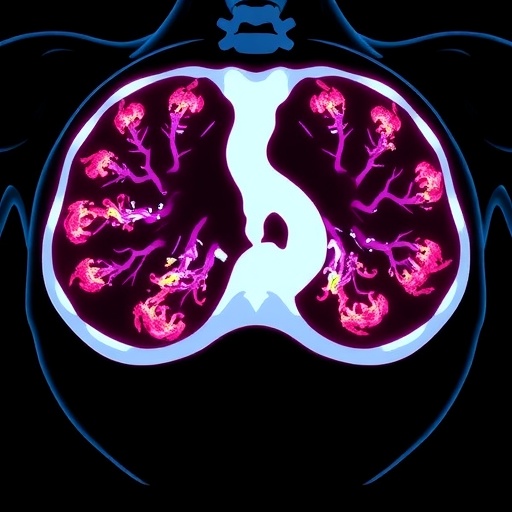In an extraordinary leap forward for oncology and immune system research, scientists have unveiled CAMFormer, a novel deep learning framework designed to revolutionize early cancer detection through the non-invasive analysis of peripheral blood. Cancer diagnosis has traditionally been reliant on invasive tissue biopsies, which are both painful for patients and limited in scalability for broad population screening or repeated longitudinal monitoring. CAMFormer overcomes these hurdles by integrating complex immune data from peripheral blood, harnessing state-of-the-art artificial intelligence to decode the intricate interplay of immune cells implicated in cancer risk.
The challenge of predicting cancer onset has long been complicated by the multilayered complexity of immune system dynamics. Tumor-immune interactions span various biological scales and involve multiple cellular and molecular actors, each contributing subtle signals that conventional diagnostic tools can struggle to capture. Peripheral blood, easily accessible through a simple draw, carries a wealth of immune information reflecting systemic immune states. However, transforming this multimodal data—encompassing gene expression profiles, immune cell population frequencies, and T cell receptor (TCR) diversity—into actionable cancer risk insights requires sophisticated modeling to uncover hidden patterns and cross-modal relationships.
CAMFormer addresses this formidable analytical challenge by leveraging a cross-attention mechanism within a multimodal Transformer architecture. Unlike traditional unimodal models that analyze each data type in isolation, CAMFormer dynamically combines information streams, enabling the model to focus on salient features across different immune modalities simultaneously. This capability allows it to capture cross-scale interactions, such as how specific immune cell frequencies correlate with genetic expression patterns or TCR diversity metrics, thereby offering a holistic and nuanced immune landscape relevant to cancer risk prediction.
During rigorous five-fold cross-validation testing on validation datasets, CAMFormer demonstrated remarkable performance metrics. It achieved an area under the receiver operating characteristic curve (AUC) of 0.92, indicating outstanding discriminatory ability between individuals at varying levels of cancer risk. Additionally, the model attained an F1-score of 0.85, highlighting its strong balance between precision and recall in accurately identifying early cancer signals. These results reflect a significant improvement over baseline methods that rely on single data modalities, underscoring the critical importance of multimodal integration in immune profiling.
The implications of these findings stretch far beyond cancer diagnosis. By accurately profiling the immune system’s early perturbations via peripheral blood, CAMFormer paves the way for more timely and less invasive cancer screening protocols. This is particularly vital as early detection remains the cornerstone of improving patient survival rates and enabling precision medicine interventions. As the model processes data from readily obtainable blood samples, it promises scalability and repeatability necessary for monitoring high-risk populations continuously or globally.
CAMFormer’s design is rooted in recent advances in artificial intelligence, especially Transformer architectures originally developed for natural language processing but now adapted for biomedical applications. The cross-attention module within the Transformer empowers the model to weigh the relevance of features across different data types contextually, a critical functionality when dealing with immunological signals that manifest variably across genomic, phenotypic, and clonal diversity dimensions. This architecture effectively captures the interplay between immune gene expression patterns, the abundance of various immune cell subsets, and TCR diversity indices, all of which contribute uniquely to the immune surveillance landscape in cancer.
Crucially, CAMFormer’s reliance on peripheral blood also circumvents limitations of tissue biopsies, such as sampling bias due to tumor heterogeneity and procedural invasiveness. Blood-based immune profiling captures systemic immune status and disease-related changes even when tumors are not easily accessible or visible. This feature elevates its utility as a generalizable screening tool and holds promise to facilitate patient stratification for immunotherapies, potentially guiding personalized treatment strategies based on immune signatures identified in the bloodstream.
The study underlying CAMFormer’s development also delved into the biological interpretability of the integrated multimodal data. By revealing how certain gene expression signatures activate in concert with specific immune cell frequency shifts and alterations in TCR diversity, researchers gained insights into early immune dysregulation patterns preceding cancer development. This understanding may fuel new hypotheses about immune evasion mechanisms by tumors and inform the design of next-generation immunomodulatory drugs targeting precise immune dysfunction pathways.
From a technological perspective, CAMFormer exemplifies the convergence of systems biology with machine learning. Its innovative cross-attention Transformer not only boosts predictive accuracy but also enhances model explainability by pinpointing which immune modalities and features most influence predictive outcomes. Such interpretability is essential for clinical adoption, enabling oncologists and immunologists to trust AI-generated risk assessments and potentially uncover new biological markers for early cancer detection.
Future directions for CAMFormer are ripe with potential. Expanding its application to broader cancer types, different patient demographics, and longitudinal immune monitoring studies could validate and refine its utility. Integration with other omics data, such as proteomics or metabolomics from peripheral blood, may further enrich the multi-layered immune profile. Additionally, embedding CAMFormer within clinical workflows as a decision-support tool could radically transform cancer diagnostics—shifting from reactive to proactive detection and care.
CAMFormer’s development also highlights the vital role of interdisciplinary collaboration. The project brought together computational scientists, immunologists, oncologists, and bioinformaticians to design, implement, and evaluate this multimodal AI framework. Their combined expertise addressed the biological complexity of immune profiling and the computational demands of cross-attention-based modeling, culminating in a tool that promises both scientific advancement and clinical impact.
On a broader scale, CAMFormer symbolizes a transformative paradigm in medicine, where AI-driven models enable minimally invasive, precise, and scalable diagnostics. By decoding the rich, multi-dimensional immune signals circulating in peripheral blood, research like this moves healthcare closer to the ideal of personalized medicine—tailoring interventions based on an individual’s unique immune landscape and cancer risk profile. This approach not only enhances patient outcomes but also optimizes healthcare resource allocation.
In conclusion, CAMFormer stands as a beacon of innovation in cancer immune profiling and risk prediction. Its application of cutting-edge deep learning techniques to integrate peripheral blood multimodal data addresses longstanding challenges in early cancer detection while providing mechanistic insights into immune system alterations. As it transitions from research to potential clinical use, CAMFormer heralds a future where AI empowers clinicians to detect cancer earlier, intervene smarter, and ultimately save more lives.
Subject of Research: Cancer risk prediction through multimodal integration of peripheral blood immune features using advanced AI models.
Article Title: Peripheral blood multimodal integration via cross-attention for cancer immune profiling.
Article References:
Li, X., Hua, Y., Liu, H. et al. Peripheral blood multimodal integration via cross-attention for cancer immune profiling. BMC Cancer 25, 1523 (2025). https://doi.org/10.1186/s12885-025-14969-1
Image Credits: Scienmag.com
DOI: https://doi.org/10.1186/s12885-025-14969-1
Tags: advanced modeling of immune system dynamicsartificial intelligence in cancer diagnosticsCAMFormer deep learning framework for oncologycross-attention mechanism in cancer researchenhancing early cancer detection methodsimmune profiling through peripheral blood analysisinnovative approaches to cancer diagnosismultimodal data analysis for cancer detectionnon-invasive cancer detection techniquespredictive analytics in oncologyT cell receptor diversity in cancertumor-immune interactions and cancer risk





